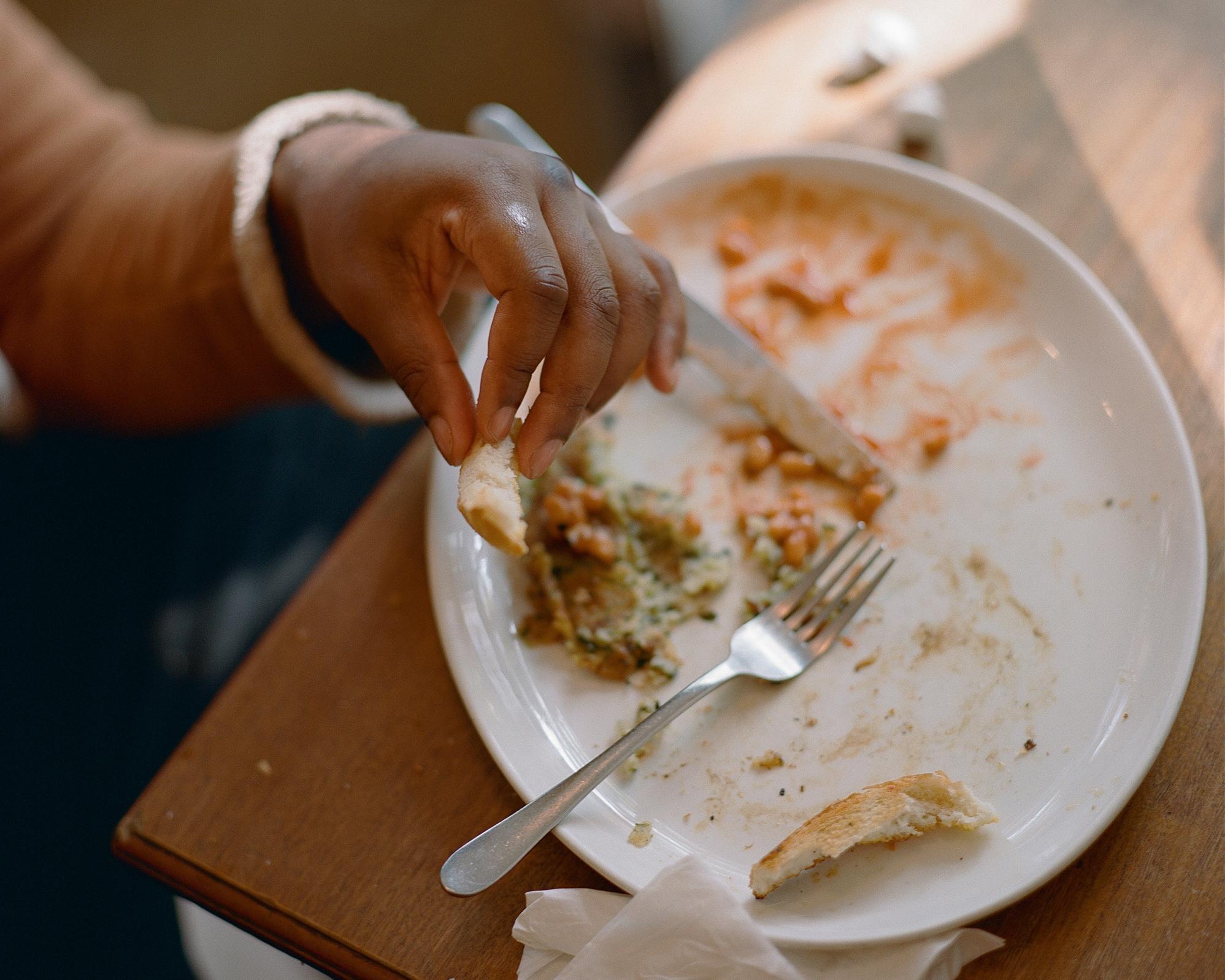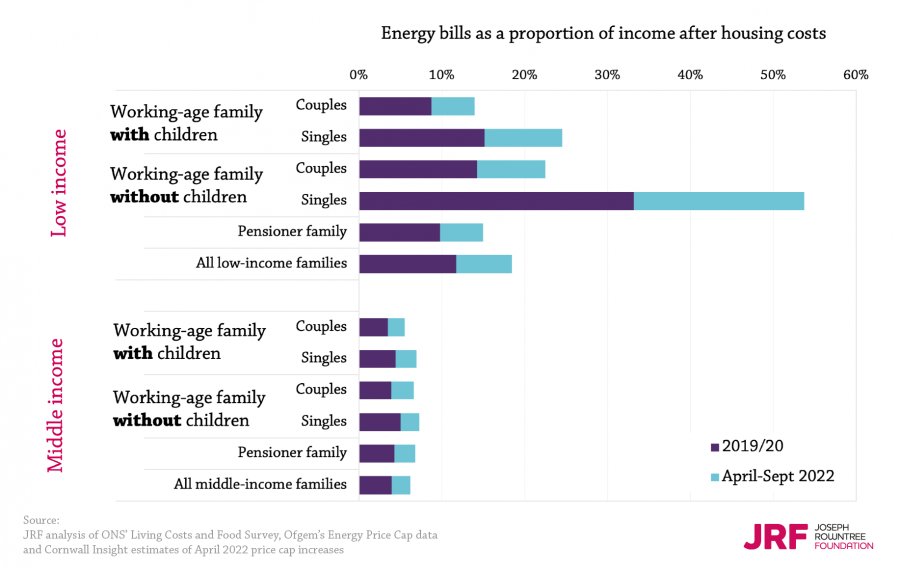Rising energy bills to 'devastate' poorest families
New analysis shows the harsher impact of the energy price cap rise on the poorest families. Urgent action is needed to ease pain of cost-of-living crisis as JRF report shows millions of families in deep or persistent poverty.
New analysis from the Joseph Rowntree Foundation finds households on low incomes will be spending on average 18% of their income after housing costs on energy bills after April. For single adult households on low incomes this rises to a shocking 54%, an increase of 21 percentage points since 2019/20. Lone parents and couples without children will spend around a quarter of their incomes on energy bills, an increase of almost 10 percentage points in the same period.
The analysis compares the household spend on gas and electricity bills of several different family types on low and middle incomes between 2019-20 and after the increase in April this year.[1]
[1]The chart shows the proportion of different households’ incomes that is spent on energy, in 2019/20 and after April 2022. The full analysis is available on request.
While there is little difference in the overall increase in bills from April, with all households facing an immediate increase of between around 40% and 47%, the difference in the proportion of household incomes these increases will represent is stark. Middle-income households will be spending on average 6% of their incomes on energy bills, and no more than 8% for any family type considered.
The figures are released alongside JRF’s flagship state-of-the-nation report which reveals a worrying increase in the number of children growing up in very deep poverty. Around 1.8 million children are growing up in very deep poverty, meaning the household’s income is so low that it is completely inadequate to cover the basics.[2] This represents an increase of half a million children between 2011-12 and 2019-20.
JRF is warning that without additional support, people already in poverty are likely to find a sharp increase in energy bills very difficult to cope with. People living in deep and persistent poverty were already under constant pressure trying to afford food, bills and other essentials. With the impact of rising energy bills expected to be much harsher for families on low incomes, there is a clear case for targeted protections to prevent serious hardship once the energy price cap is lifted.
Following a cut to Universal Credit in the autumn, the level of support for people who are unable to work or looking for work remains profoundly inadequate. JRF is calling for an immediate emergency payment for people on the lowest incomes to help prevent hardship in the months ahead.
Katie Schmuecker at JRF said:
“The reality for many families is that too many children know the constant struggle of poverty. The fact that more children are in poverty and sinking deeper into poverty should shame us all.
“The case for targeted support to help people on the lowest incomes could not be clearer. But this must go hand in hand with urgent action to strengthen our social security system, which was woefully inadequate even before living costs began to rise.
“Our basic rate of benefits is at its lowest real rate for 30 years and this is causing avoidable hardship. The Government must do the right thing and strengthen this vital public service.
“Rising energy prices will affect everyone, but our analysis shows they have the potential to devastate the budgets of families on the lowest incomes. The Government cannot stand by and allow the rising cost of living to knock people off their feet.”
| Family type | Low income family | Middle income family | ||||
| Proportion of income After Housing Costs spent on gas and electricity | Ppt increase | Proportion of income After Housing Costs spent on gas and electricity | Ppt increase | |||
| 2019/20 | April-Sept 2022 | 2019/20 | April-Sept 2022 | |||
| Working-age family with children[2] | 10% | 16% | 6% | 3% | 6% | 2% |
| of whom with couple parents | 9% | 14% | 5% | 3% | 6% | 2% |
| of whom with lone parent family | 15% | 25% | 9% | 4% | 7% | 3% |
| Working-age family without children[2] | 19% | 29% | 11% | 4% | 6% | 2% |
| of whom couple without children | 14% | 22% | 8% | 4% | 6% | 3% |
| of whom single adults without children | 33% | 54% | 21% | 5% | 8% | 2% |
| Pensioner family | 10% | 15% | 5% | 4% | 7% | 2% |
| All families | 12% | 18% | 7% | 4% | 6% | 2% |
[2] Very deep poverty is defined as household income equivalent to or less than 40% of the average income for their family type in the UK. On average across all family types, a household in very deep poverty would have an income of £9,900 or less per year after housing costs, taxes and National Insurance contributions are deducted although this varies by family type as shown in this table.
| Household type | Maximum household income after housing costs, taxes and NI | Average household income after housing costs, taxes and NI | ||||||
| Very deep poverty | Deep poverty | Poverty | Average income | |||||
| Lone parent with two children, one 14 or over and one under 14 | Annual | Weekly | Annual | Weekly | Annual | Weekly | Annual | Weekly |
| £11,900 | £228 | £14,900 | £285 | £17,900 | £343 | £29,800 | £571 | |
| Couple with two children one 14 and over and one under 14 | £16,100 | £308 | £20,100 | £385 | £24,200 | £462 | £40,300 | £771 |
| Adult, no children | £5,800 | £110 | £7,200 | £138 | £8,700 | £166 | £14,400 | £276 |
| Couple with no children | £9,900 | £190 | £12,400 | £238 | £14,900 | £285 | £24,900 | £476 |
For notes on our methodology please email analysis@jrf.org.uk

This news article is part of the cost of living topic.
Find out more about our work in this area.

